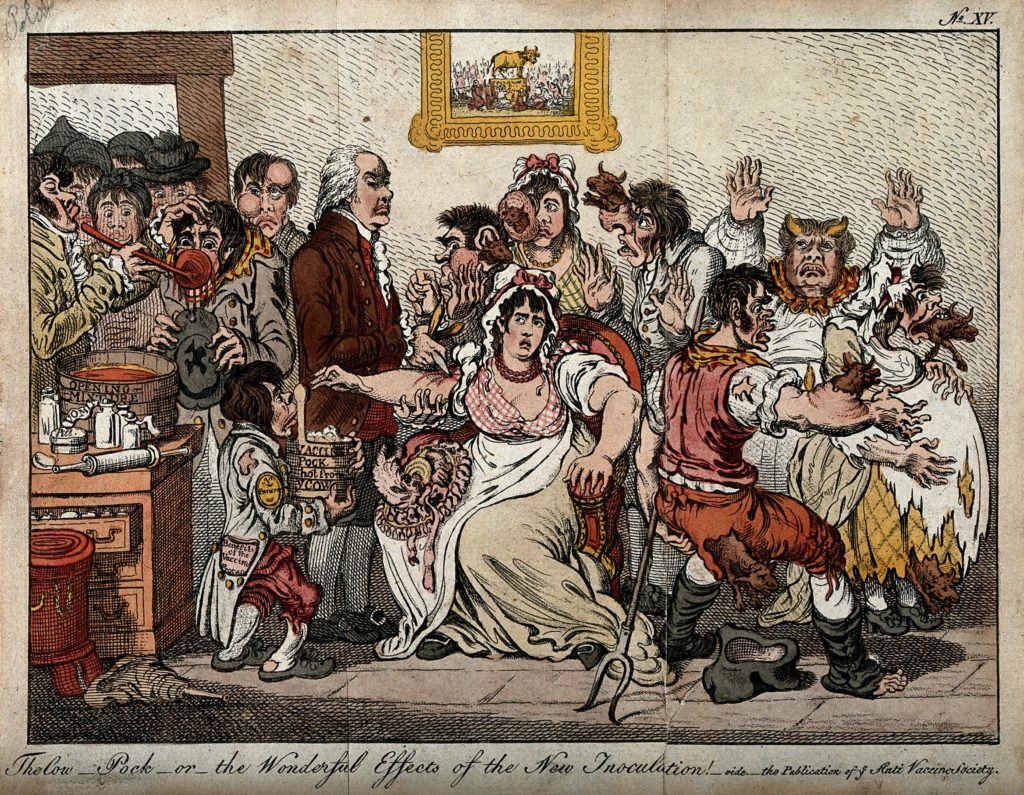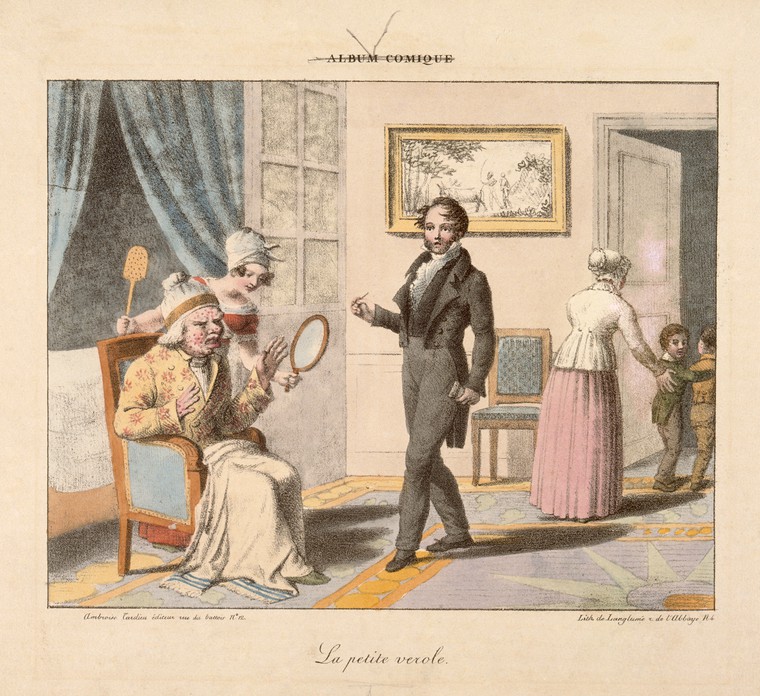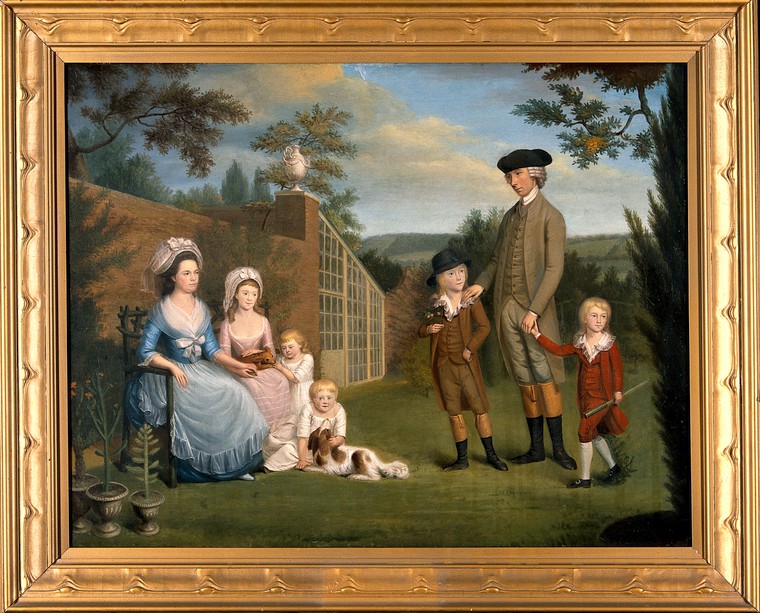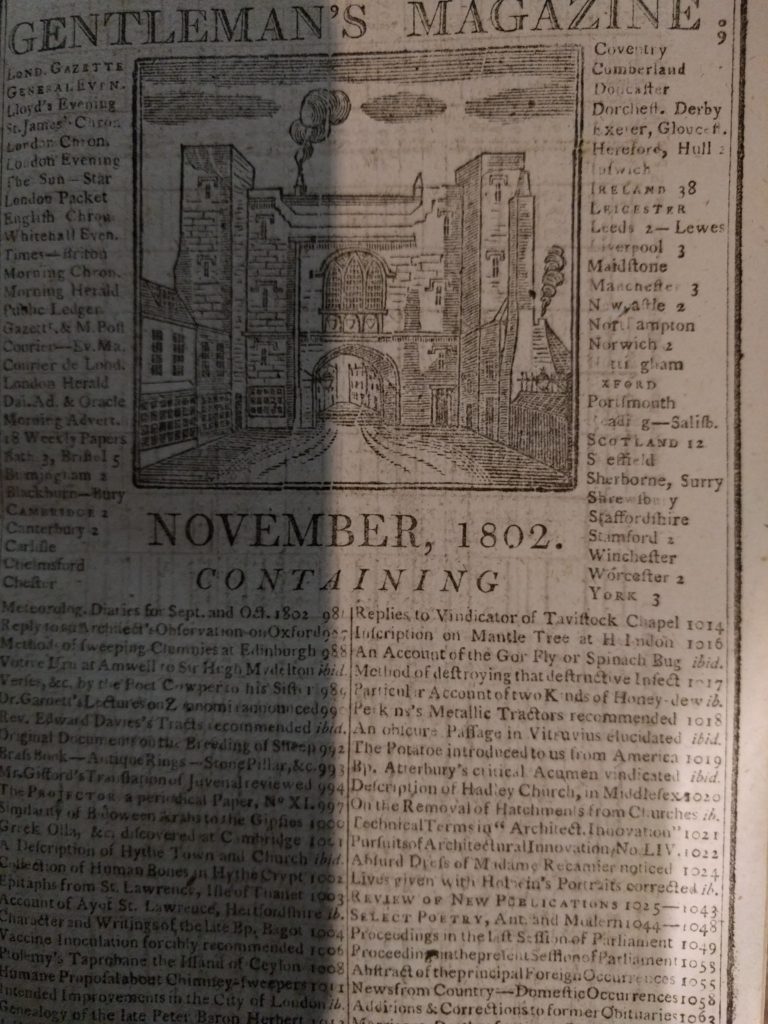With all the doom and gloom around at the moment, I thought I’d look at what was being reported in The Gentleman’s Magazine for November 1802.
Well, it wasn’t better then, much worse in fact, particularly with regard to a disease that we no longer have to contend with… smallpox.

I discovered a letter from one J. C. Lettsom, which was a strong, emotive call for more children to be inoculated. He asserts that about 36,000 deaths in Britain every year were due to smallpox, with 8,000 of these in London alone. It is known that the disease was fatal for thirty per cent of those who caught it, and many of those who survived were afflicted with disfiguring scars. Blindness was another complication of the disease – according to the World Health Organisation (WHO), a third of all reported cases of blindness in 18th century Europe were due to smallpox.
But in 1798 some help was at hand, when Edward Jenner discovered that inoculation with the milder disease of cowpock offered protection against the deadlier smallpox. It also came without the risk of death that was sometimes the result of inoculation with smallpox.

In his letter, Lettsom points out that, ‘It was the practice formerly to attempt lessening the danger of the Small-pox by inoculating persons with it; but this often proved fatal, and it is always infectious… the Cow-pock is not catching or infectious; and if it could be caught, it is not dangerous.’
Using highly emotional language, Lettsom goes on to accuse parents who do not inoculate their children with the cow pock as being ‘acessory to their deaths.’ He continues. ‘As the Vaccine Inoculation is a certain security against the Small-pox; as it introduces no constitutional disease or blemish, and never is fatal; what apology can such parents and guardians offer for neglecting the means of prevention and security?’
He calls on magistrates to set an example by having their own children inoculated and says they should also encourage others to do so. A man with an eye to the bigger picture, Lettsom believes that the Government should also do their part by supporting a scheme of vaccination, ‘Plans so interesting to the well-being of the Community, and prosperity of the State, will doubtless be supported by the liberality of Government, and thereby ultimately eradicate the greatest scourge of human existence that ever desolated the Universe.’
He mentions that although there are several institutions which offer free cow-pock vaccinations to the poor, notably the Vaccine Institution at Golden Square, the incidence of smallpox is still so great, that their impact is neglible.

I was intrigued by this lettter, and decided to find out more about its author. John Coakley Lettsom (1744-1815), a physician and philanthropist, was born in the British Virgin Islands to a Quaker West Indian planter and an Irish mother. He was sent at the age of six years to be educated in Lancashire. After being apprenticed at first to an apothecary, Lettsom moved to London and began medical training at St Thomas’ Hospital. His studies were interrupted by the death of his father, and he returned to the family estate in the Virgin Islands, where he freed the slaves he’d inherited. Making his fortune as the sole doctor in the islands, he returned to Europe and completed his medical studies.

Lettsom’s reputation as a physician grew, he became a Fellow of the Royal Society, and founded the General Dispensary, and the Medical Society of London. The institutions associated with his name are numerous: the Royal Humane Society, a sea-bathing infirmary at Margate, the Royal Jennerian Society, as well as societies for the relief of widows and orphans of medical men, help for debtors, and the Philanthropic Society for homeless children.
Lettsom really was a force for good, and it appears that the letter I discovered in the Gentleman’s Magazine of November 1802 was not a one-off. He was prolific in writing about issues that reflected his interests as a physician, philanthropist, botanist, mineralogist, and collector.

Importantly too, he was an abolitionist, as demonstrated by his immediately freeing the slaves he inherited from his father. Ironically, on his death, Lettsom was a slave-owner. His son had married a wealthy widow and thereby acquired 1,000 slaves. Both the son and his wife died shortly after their marriage, and the property and slaves were left to John Lettsom. Tragically, the man who had worked hard to abolish slavery, did not live long enough to free the ones that had come to him from his son and daughter-in-law.
Happily, these days slavery is no longer legal in all right-thinking societies, and we no longer have to contend with the threat of smallpox, which the WHO declared had been eradicted in 1980.
So my little foray into The Gentleman’s Magazine led me down a wonderful research rabbit-hole. I hope you’ve found it as interesting.
Sources
The Gentleman’s Magazine, November 1802
https://wellcomecollection.org/works/kg8b6nxb
Memoirs of the life and writings of the late John Coakley Lettsom. London: Nichols, Son and Bentley, 1817. Google Scholar
Images
Edward Jenner among patients, coloured etching after J. Gillray, 1802. Credit: Wellcome Collection. CC BY
A maid shows an old man his smallpocked face in a hand mirror. Coloured lithograph by Langlumé, 1823. Credit: Wellcome Collection. CC BY
John Coakley Lettsom (1733-1810), physician, with his family, in the garden of Grove Hill, Camberwell, ca. 1786. Oil painting by an English painter, ca. 1786. Credit: Wellcome Collection. CC BY


I wonder what provision Lettsom had to make for his slaves when he freed them, and what choices they had as free men and women.
Change of subject — family group — that’s some glasshouse in the background!
That would be another interesting research rabbit hole to explore, Charlotte! He was a seriously wealthy man, so I’d like to think he did something to ensure secure futures for the people he freed.
Yes, the glasshouse in the painting, another symbol of his wealthy status.
Congrats on spotting him 🙂
Thank you! I’ve discovered all sorts of people whose lives justify far more research… so many stories, so little time!!
This was such an informative post. I knew that cowpox prevented people from later catching smallpox, but I had no idea there were charities set up to purposefully give cowpox to poor families in order to limit the spread of smallpox. That’s fascinating. It’s too bad they weren’t more widespread.
Thank you, Lydia. Trawling through old publications certainly throws up some interesting facts.